Container spot rates have peaked as all major trades see prices fall
There was more evidence in this week’s container port freight markets that peak prices on ...
TFII: SOLID AS USUALMAERSK: WEAKENINGF: FALLING OFF A CLIFFAAPL: 'BOTTLENECK IN MAINLAND CHINA'AAPL: CHINA TRENDSDHL: GROWTH CAPEXR: ANOTHER SOLID DELIVERYMFT: HERE COMES THE FALLDSV: LOOK AT SCHENKER PERFORMANCEUPS: A WAVE OF DOWNGRADES DSV: BARGAIN BINKNX: EARNINGS OUTODFL: RISING AND FALLING AND THEN RISING
TFII: SOLID AS USUALMAERSK: WEAKENINGF: FALLING OFF A CLIFFAAPL: 'BOTTLENECK IN MAINLAND CHINA'AAPL: CHINA TRENDSDHL: GROWTH CAPEXR: ANOTHER SOLID DELIVERYMFT: HERE COMES THE FALLDSV: LOOK AT SCHENKER PERFORMANCEUPS: A WAVE OF DOWNGRADES DSV: BARGAIN BINKNX: EARNINGS OUTODFL: RISING AND FALLING AND THEN RISING

While container spot rates on the Asia-Europe and Asia-North America trades continued to remain elevated, year on year, due to the Red Sea crisis, collapsing rates on other trades continue to dent carriers’ earnings outlook.
Cosco-owned OOCL today reported its operational update for first quarter, which showed that despite the nascent recovery in pricing since Yemen’s Houthi rebels began attacking commercial shipping, trades that remain unaffected by Cape of Good Hope diversions continue to show considerable weakness.
The Hong Kong-headquartered carrier said Q1 revenues decreased 9% year on year, to $1.98bn, and average revenue per teu decreased 12%, while liftings increased 3.4% and its loadable capacity increased 2.2%.
There was a huge variation across its four main trades – transpacific, Asia-Europe, transatlantic and intra-Asia, which remains its largest trade in terms of volume. Q1 liftings were flat on the transpacific, at 450,000 teu, and down 7.5% on Asia-Europe, to 360,000 teu.
However, total revenues for these trades grew 13% and 0.8% respectively, indicating the January surge in freight rates as vessel diversions and pre-Chinese New Year demand pushed rates up.
Meanwhile, despite an 11.3% increase in volumes on intra-Asia/Oceania routes, to 863,000 teu, OOCL saw a 17.4% decline in revenue, and the situation was even worse on the transatlantic, where a 2.1% growth in volumes was accompanied by a 50.6% decline in revenue.
However, this week’s spot freight data from may give transatlantic carriers grounds for cautious optimism: the Xeneta XSI index recording a 3% increase in westbound spot rates, to $1,993 per 40ft; while Drewry’s WCI has the trade declining by 1%, to $2,244.
“Drewry expects a minor decrease in transpacific spot freight rates, whereas transatlantic and Asia-Europe head towards stability in the coming weeks,” the UK-based analyst said in its weekly pricing report.
Listen to this clip from the latest episode of The Loadstar Podcast, where head of ocean freight North America at Rhenus Logistics, Stephanie Loomis, talks about the surprising US ocean import volumes:
On the Asia-Europe trades, Derwry’s Shanghai-Genoa leg saw pricing stabilise at $3,632 per 40ft, bringing to an end 10 weeks of successive rate declines.
The WCI’s Shanghai-Rotterdam leg recorded a 1% decline, to $3,050 per 40ft, while the Xeneta’s Asia-North Europe XSI saw a 0.7% bump, to $3,365 per 40ft.
This marginal turnaround was corroborated by the Freightos FBX index, which saw Asia-North Europe rates rise 2%, to $3,325 per 40ft.
“Despite the Baltimore event, the broader drivers in ocean freight – easing demand, as container trade is in its slow season and stabilised operations for Red Sea diversions – have continued to ease pressure on freight rates. But prices will remain above normal as long as the Red Sea threat persists,” a Freightos commentary said.
“Rates are now in the $3,000-$4,000 per 40ft range for these lanes, which, recent April rate announcements suggest, is the carriers’ hoped-for floor as long as diversions continue to increase their costs and soak up capacity,” it added.
Pricing declines continued on the transpacific and Asia-US east coast, but were also relatively marginal, with the WCI seeing a 2% week-on-week drop in Shanghai-Los Angeles rates, to $3,634 per 40ft, and a 4% week-on-week decline in Shanghai-New York, to $4,710 per 40ft.
Speaking on the Loadstar Podcast yesterday, Rhenus’s North America director, Stephanie Loomis, said that with annual transpacific contracts due to be concluded by the end of this month, many shippers continued to “slow-walk” on discussions, as current spot rates and carriers’ targeted contract levels still diverged.
“Overall, most of the negotiations – or maybe lack thereof – really are being driven by the spot market and the spread between what the carriers are wanting to offer on new rates and what the shippers think is appropriate,” she said.
Ms Loomis added that this was especially the case on the interior point intermodal (IPI) destinations.
“That’s really where the dissension is. And what I’m hearing, and what I’m experiencing, is that carriers are not budging yet – but there’s still 20 days to go,” she said.
Comment on this article